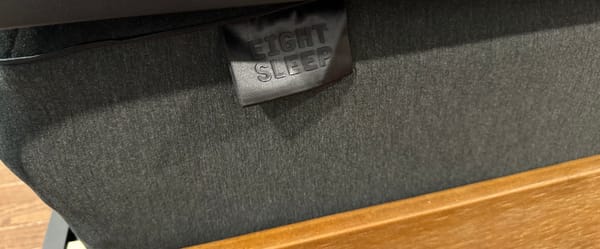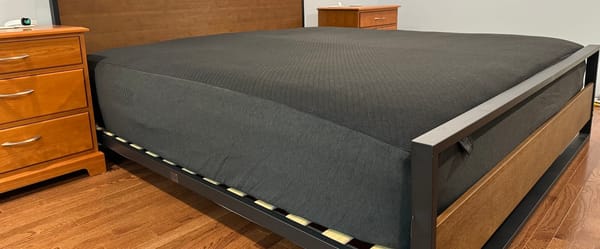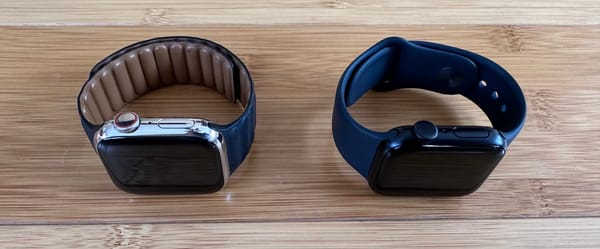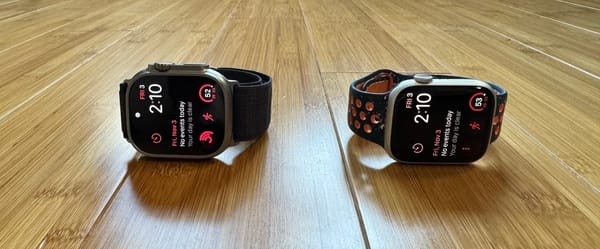iPad Air vs. iPad (8th Gen): Is the iPad Air $300 better?
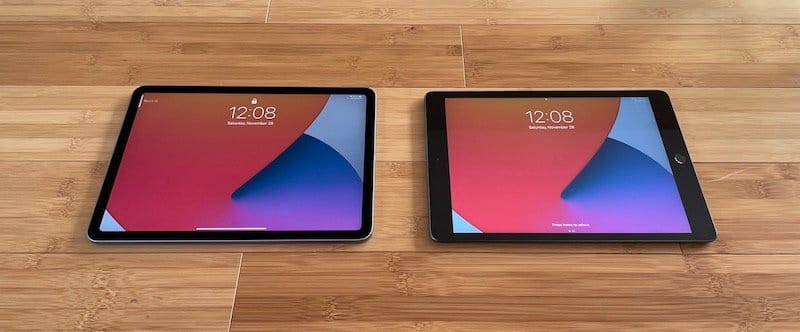
After a month of testing, I determined the iPad (8th Gen) is the iPad for most people. It’s a great device for consuming content and one of the best values in tech.
iPad Air (4th Gen) has a brilliant display and design. And the addition of the Magic Keyboard makes it substantially more useful. Unfortunately, the iPad Air and Magic Keyboard combine to cost almost the same as a more capable device (MacBook Air).
Want to learn how I reached this conclusion? Read on to see the detailed breakdown of screen, capabilities, and hardware that informed my overall impression.
Screen Quality
iPad Air (4th Gen)
Summary: iPad Air has a larger display with rounded corners, but both have the same pixel density and brightness. iPad Air’s display is substantially better because it has P3 wide color, True Tone, antireflective coating, and it’s laminated.
Laminated display:
- The glass is glued to the LCD, which gives the feeling that you’re touching the pixels. It feels like one piece. What does this mean practically?
- iPad Air mimics your phone’s touch screen experience. Apple hasn’t sold an iPhone in ten years without a laminated display, and most smartphones on the market have laminated displays.
- Using an Apple Pencil to draw or annotate is a lot of fun. It feels more precise when you’re drawing directly on the pixels.
P3 Wide Color:
- The colors are more true to real life, which would be important if you’re a photo editor or artist.
- Apple says it has deeper greens and reds, but I can’t tell much of a difference compared to the eighth generation iPad. You might see a slight difference when watching a Hollywood movie, but most won’t notice it in everyday life.
True Tone:
- iPad Air has a True Tone display that changes the screen’s color temperature based on the surrounding light to make the screen look like white paper at all times. It’s more noticeable when you’re outside because the white colors get warmer.
- True Tone isn’t a game-changer, but it makes reading easier on your eyes.
Coating:
- iPad Air has an antireflective coating. I thought this was just marketing language, but there’s a noticeable difference when you’re outside or in a room with bright lights.
iPad (8th Gen)
Summary: The 8th generation iPad doesn’t have a laminated display, which means there’s an air gap between the glass and the LCD. Tech nerds will hate the air gap, but most people probably won’t notice or will get used to it. iPad doesn’t have True Tone or P3 Wide Color, but neither are game-changers.
Air gap:
- The 8th generation iPad doesn’t have a laminated display, which means that there’s an air gap between the glass and the LCD.
- Will the average consumer notice the gap? I’m not sure. My parents had no idea, but a couple of friends spotted the difference right away and said the screen felt “fake.” As a gadget enthusiast, the air gap was the first thing that I noticed and a deal-breaker for me.
- iPad Air 2 and iPhone 4 were the first devices to get a laminated display and most modern smartphones have a laminated display. If you’re a big tech lover, you won’t love the transition back.
- The screen doesn’t feel like a solid piece of material. You can feel the screen move slightly as you push down. It feels like dated technology.
- Drawing with the Apple Pencil feels more sluggish and less precise.
- Keep in mind, you won’t find a more spoiled tech consumer than I am. I rarely hold onto a device that’s more than two years old. I’m fine with the screen as long as I don’t have to type often because that’s when it’s most apparent.
Other:
- The screen is more reflective, but under normal indoor lighting conditions, you can see everything perfectly.
- The display doesn’t adjust the colors automatically. It stays static. True Tone technology has been a staple of Apple products since 2017, so it’s strange to use a device without it when you’re used to it. True Tone is nice to have, but if you’re coming from outside the Apple ecosystem, it shouldn’t weigh into your decision.
Accessories
iPad Air (4th Gen)
Summary: iPad Air’s biggest advantage is that it’s compatible with the Magic Keyboard. The downside is that the Magic Keyboard is $300, making your purchase about the price of the more capable MacBook Air. iPad Air works with the second-generation Apple Pencil and more accessories because it uses USB C.
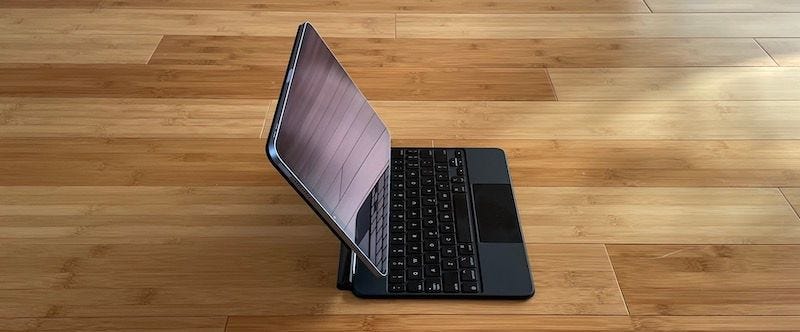
Magic Keyboard:
- The Magic Keyboard is great. It provides a typing experience similar to a real laptop.
- The keys are backlit and they feel like real keys.
- The trackpad uses a little dot cursor that moves and then clings to apps and other objects. It’s a great experience and makes more sense for a tablet than a mouse pointer.
- The problem is that the Magic Keyboard for iPad Air is $300, which puts the whole unit into MacBook Air’s price territory.
- The magic keypad is heavy, which gives it close to the same weight as MacBook Air.
- The iPad Air is plenty powerful to handle advanced tasks, but if you’re used to certain workflows from a Mac or another laptop, it’s probably not a perfect fit. iPad Air is best to supplement your MacBook usage, not take over it.
Other:
- It works with the second generation Apple pencil, which charges by magnetically attaching to the top side of the iPad Air.
- Because iPad Air uses USB C rather than Lightning, it’s compatible with more accessories.
iPad (8th Gen)
Summary: The eighth-generation iPad uses the clunky first-generation Apple Pencil. It works with the older Smart Keyboard too, but it makes more sense to buy a generic $20 Bluetooth keyboard instead.
- It works with the first-generation Apple Pencil, but as I wrote above, due to the non-laminated screen, the implementation isn’t perfect.
- It has the Smart Connector for connecting Apple’s Smart Keyboard. The Smart Keyboard costs $159, while the iPad is $329. The keyboard’s pricing doesn’t make sense and the keyboard isn’t very good. The keys don’t feel like keys from a laptop. They feel like keys from a tablet case. There’s not much give and it’s not very satisfying to tap.
- Luckily, it’s compatible with any Bluetooth keyboard and there are good options in the $20 range.
- The iPad Smart Cover for $49 works as a cover and as a stand when you fold it.
Performance
iPad Air (4th Gen)
Summary: iPad Air uses Apple’s A14 processing chip. It’s the same chip in the iPhone 12 models. You won’t notice a difference in your daily use because all apps open at the same speed. Videos, music, social media, and internet browsing function the same on A12 as they do with A14.
Notes:
- The A14 Chip is overkill for most tablet tasks and most users will struggle to challenge it.
- You’d probably see a difference in performance with premium video and photo editing services, but if you’re using these, I doubt you’re in the market for the entry-level iPad anyway.
iPad (8th Gen)
Summary: iPad uses Apple’s A12 processing chip. It’s the same chip iPhone XS uses. It has plenty of power for tasks that a typical tablet user will perform. In fact, for web browsing, music listening, video watching, document creating, emailing, and moving between windows, your experience is identical to the A14 chip.
Notes:
- You should be able to do most video and photo editing, but extensive gaming or apps that require multiple cores might give it a challenge.
- I did some iMovie editing and played Mario Kart without any issues. It was as smooth as butter.
Other Hardware
iPad Air (4th Gen)
Summary: iPad Air has a stereo speaker setup that blows iPad’s speakers out of the water. The back-facing camera is a solid upgrade The front-facing camera is an improvement, but it’s not substantial. The new Touch ID gives the iPad Air a full-screen display, but unfortunately, it’s not as convenient and takes time to get used to.
Camera:
- The front-facing camera is 7MP with and records in 1080p. It sounds like a substantial increase from the eight generation iPad, but the real-life performance doesn’t show a huge difference (watch my demo).
- The Smart HDR from the front-facing camera helps to not blow out bright backgrounds behind you.
- The back camera is 12MP with a ƒ/1.8 aperture.
- The back camera records in 4K at 24 fps, 30 fps, or 60 fps.
Storage:
- The default storage option is 64GB. It’s $150 extra to bump up to 256GB.
Speakers:
- It has a “two-speaker audio landscape mode,” which gives you true stereo sound. There’s one speaker located on each side of the iPad Air.
- The sound quality is surprisingly great because it doesn’t sound like it’s coming from a tablet.
- It’s amazing for watching movies.
Touch ID:
- I’m not sold on iPad Air’s new Touch ID. I loved the concept, but something seems off. Without the home button, my mind expects that Face ID will work without thinking. I want to swipe up from the bottom and open, but then the keypad comes up asking for my passcode.
- It doesn’t work as flawlessly as the Touch ID on iPad.
- My right hand is my dominant hand, so with the Touch ID on the left side, it messed with my brain.
- There’s nothing wrong with the new Touch ID. Anyone can get used to it, but it wasn’t what I expected and I prefer Face ID. I prefer Touch ID on the regular iPad, but the extra screen is a worthy sacrifice.
iPad (8th Gen)
Summary: iPad has the always reliable first-generation Touch ID sensor. The speakers and front cameras work as intended, but they’re not great.
Camera:
- The front-facing camera takes 1.2-megapixel photos and it’s only capable of 720p video. The details on your face get washed away and the video quality looks terrible when there are two types of different lighting because there’s no HDR.
- The back camera is 8MP with a ƒ/2.4 aperture.
- The back camera records at 1080p at 30 fps.
Storage:
- The default storage option is 32GB. It’s $100 extra to bump up to 128GB.
Touch ID:
- It uses a first-generation Touch ID sensor. It’s fast enough and detects my thumb on the first try almost every time.
Speakers:
- The speakers sound fine, but they still sound like tablet speakers.
Design
iPad Air (4th Gen)
Summary: iPad Air has squared-off corners like the iPad Pro and iPhone 12. It feels great in the hands. It’s slightly lighter and looks amazing. Because both iPads perform similarly and have a wide price gap, design and aesthetics are an important aspect when choosing.
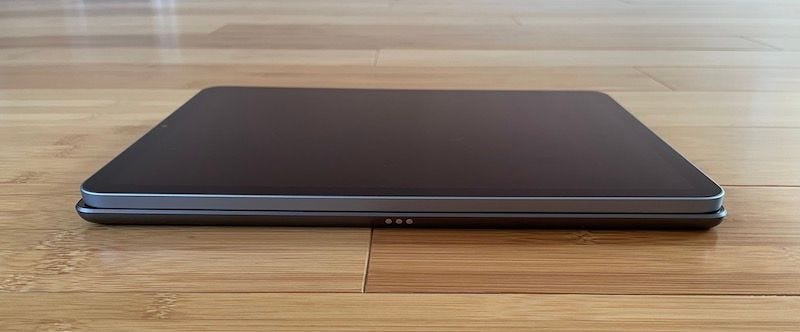
Colors: It comes in Silver, Space Gray, Rose Gold, Green, and Sky Blue. I went with the Sky Blue model and not as blue as I had hoped for. It looks silver with a little bit of blue sprinkled in.
iPad (8th Gen)
Summary: iPad has large bezels, but it comes in the time-tested classic iPad design. Some may call it a stale design, but for practical purposes, it functions just fine. It weighs and has about the same thickness as iPad Air. If you want to be on the cutting edge of design, the eight generation iPad isn’t the answer.
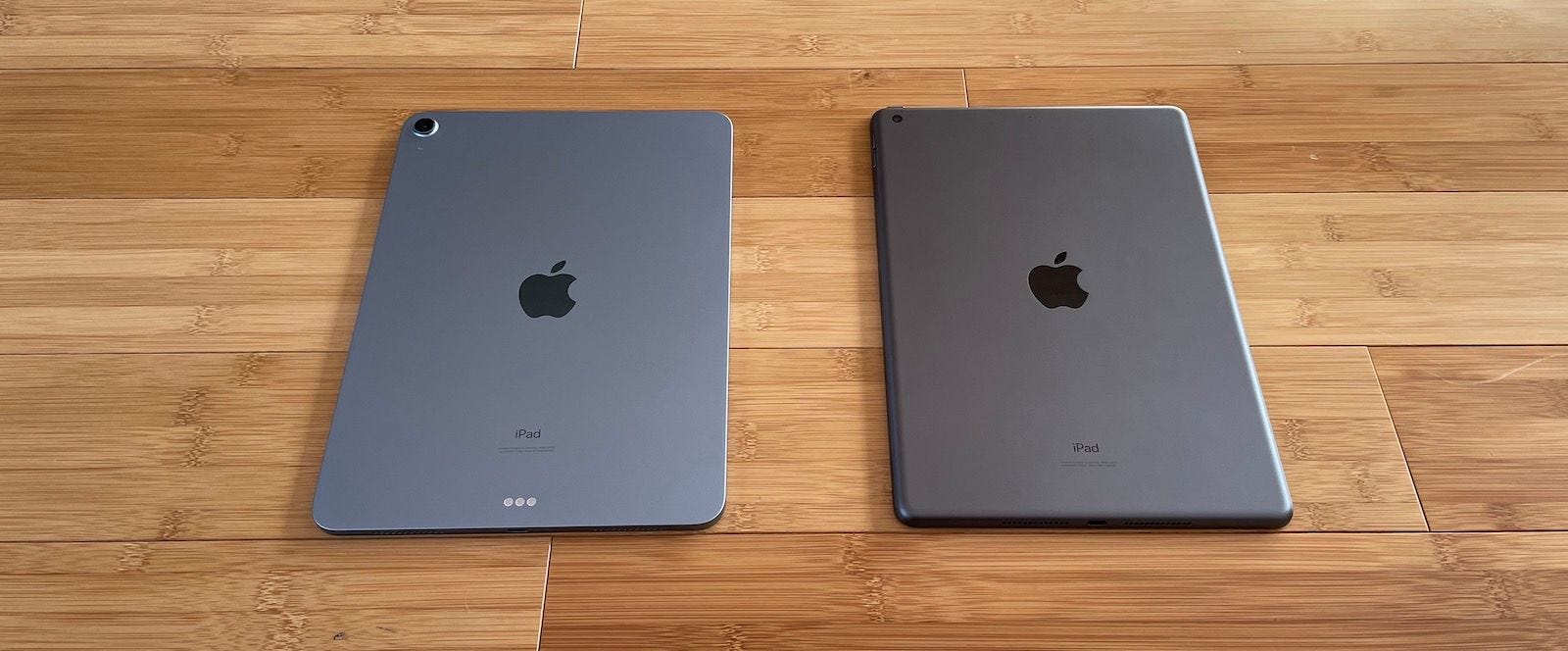
Colors: It comes in Silver, Space Gray, and Gold.
Which is best for you?
iPad Air (4th Gen)
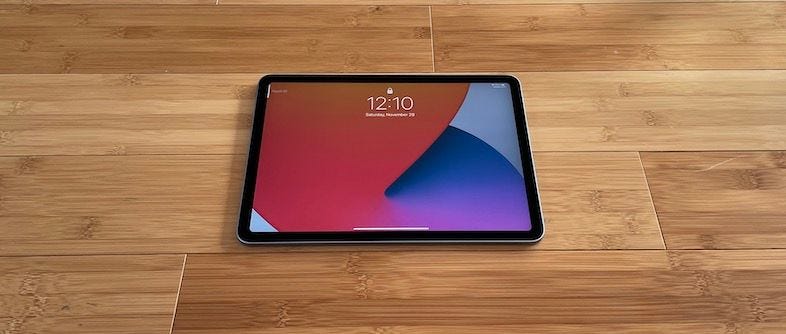
- Screen (A+)
- Capabilities (B+)
- Appearance (A+)
Get the iPad Air if you're a diehard Apple fan with no money constraints who wants a beautifully designed product. iPad Air is a powerful computer with a great display, but for most tasks, it's only slightly better than the iPad (8th Gen). iPad Air gets more powerful with the Magic Keyboard, but it’s the same price as a MacBook Air.
iPad (8th Gen)
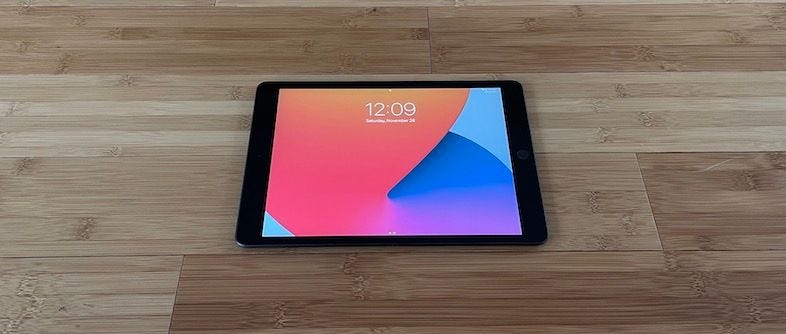
- Screen (C)
- Capabilities (B-)
- Appearance (B)
Get the iPad (8th Gen) if you want an amazing device for content consumption. It has more power than most tablet users will ever need with the same features as iPad Air. Tech nerds will hate the non-laminated display, lack of True Tone, the stale appearance, but non-tech savvy people won't notice any of these.

